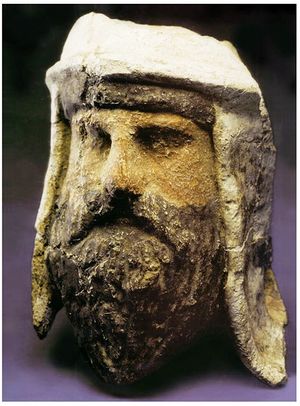تخارستان
تـُخارِستان هو اسم منطقة باكتريا في آسيا الوسطى الواقعة في كل من أفغانستان وتركمنستان بعد أن استقرت فيها القبائل التركية في القرن الثاني قبل الميلاد.
أول ذكر لاسم "تخارستان" ورد في مصادر بوذية صينية (ڤيبهاسا ساسترا) في القرن الرابع ق.م.. إلا أن أول ذكر للتخاريين كان في القرن الأول ق.م. على لسان المؤرخ سترابو حيث قال: "التخاريون والآسياني والپاسياني والسكارولي اشتركول في تدمير المملكة الإغريقية الباكترية" في النصف الثاني من القرن الثاني ق.م. بطليموس (في القرن الثاني ق.م.) ذكر أيضاً قبيلة تخارية كبيرة في باكتريا، ذاكراً الدور المحوري للتخاريين بين القبائل الأخرى في باكتريا.
منطقة تخارستان هي نفسها منطقة باكتريا كوشان، بما فيها مناطق صرخنداريا، طاجيكستان الجنوبية وأفغانستان الشمالية.
من القرن الثالث إلى القرن الرابع الميلاديين حكم الساسانيون تخارستان. وفي القرن الخامس حكمها الخيونيون والهفتاليون. وفي القرن السابع بعد حكم وجيز من الخاقانات الأتراك حكمها العرب.
الجغرافيا

التاريخ
داشيا وطخارى وطخارستان
Daxia, Ta-Hsia, or Ta-Hia (الصينية: 大夏; پنين: Dàxià) was the name given in antiquity by the Han Chinese to Tukhara or Tokhara: the central part of Bactria. The name "Daxia" appears in Chinese from the 3rd century BC to designate a little-known kingdom located somewhere west of China. This was possibly a consequence of the first contacts between China and the Greco-Bactrian Kingdom.


Kujula Kadphises, the xihou (prince) of the Yuezhi, united the region in the early 1st century and laid the foundations for the powerful, but short-lived, Kushan Empire.
In the 3rd century AD, Tukhara was under the rule of the Kushanshas (Indo-Sasanians).
The form Tokharistan – the suffix -stan means "place of" in Sanskrit – appeared for the first time in the 4th century, in Buddhist texts, such as the Vibhasa-sastra.
During the 5th century, Bactria was controlled by the Xionites and the Hephthalites, but was subsequently reconquered by the Sassanid Empire.
دخول الإسلام
By the mid-7th century, Islam under the Rashidun Caliphate, had come to rule much of the Middle East and western areas of Central Asia.[2]
In 663, the Umayyad Caliphate attacked the Buddhist/Hindu Shahi dynasty ruling in Tokharistan. The Umayyad forces captured the area around Balkh, including the Buddhist monastery at Nava Vihara, causing the Shahis to retreat to the Kabul Valley.[2]
انظر أيضاً
- Bakhtiari people
- Dard people
- Bactria–Margiana Archaeological Complex
- Tillya Tepe
- Bactrian camel
- Bahlika people
- Greater Khorasan
- Dalverzin Tepe
- Balkh
الهامش
- ^ أ ب Metropolitan Museum of Art exhibition
- ^ أ ب History of Buddhism in Afghanistan by Dr. Alexander Berzin, Study Buddhism
وصلات خارجية
- Bactrian Coins
- Bactrian Gold
- Livius.org: Bactria
- Batriane du nord—about the Termez region, an archeological site
- Art of the Bronze Age: Southeastern Iran, Western Central Asia, and the Indus Valley, an exhibition catalog from The Metropolitan Museum of Art (fully available online as PDF), which contains material on Bactria

